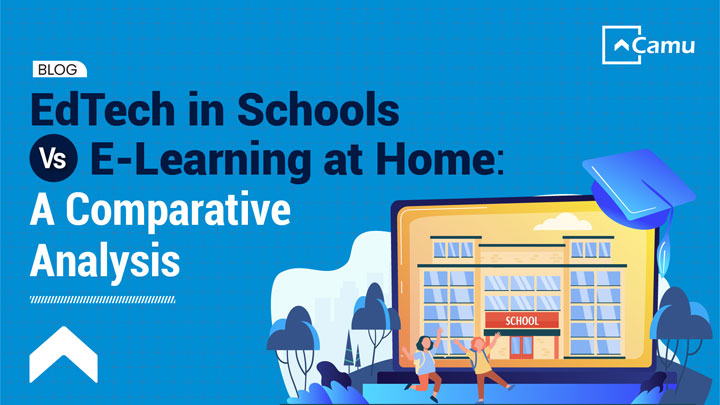
EdTech in Schools vs E-Learning at Home: A Comparative Analysis
From smart boards to VR-enabled laboratories, and video-based lessons to the gamification of assessments, the use of technology within institutions is ever-increasing.
EdTech deployed in classrooms not only facilitates learning but fosters collaboration and improves performance.
On the other hand, as communication technology leapfrogs, EdTech has taken one step further to include learning from home i.e., E-Learning / Online Learning.
Here, students can take courses online via electronic devices such as computers, tablets and smartphones.
But while ‘Home Tech’ has its obvious benefits of less travel time and reduced institutional costs, many argue that a lack of physical interaction can be detrimental to a student’s progress – mentally and emotionally.
In this blog, we review EdTech in classrooms versus E-Learning at home, and offer up a solution that meets halfway.
EdTech or Home Tech?
EdTech (Educational Technology) is what makes E-Learning (Electronic Learning) a possibility through the use of technology tools and resources.
Alternately, E-Learning is disrupting the realm of EdTech by taking the learning experience to wherever the student may be.
What’s the difference?
Well, the latter is a subset of the former.
While one is deploying technology within classrooms, the other is leveraging technology remotely.
But which one is more efficient for improved student outcomes?
It’s important to understand that both have their own set of benefits and drawbacks.
For instance, the classroom environment is a more dynamic one, as it encourages active discussion and debate.
Teachers and students have a better chance of connecting when in a face-to-face situation.
Students can ask questions directly and acquire knowledge instantly without any lag time.
That being said, there is less autonomy and flexibility within a brick-and-mortar model.
Students are confined to a physical space and must adhere to classroom norms and schedules.
Furthermore, they have the additional burden of travel costs.
E-Learning, alternatively, makes learning more accessible and convenient.
Students can study at their own style and pace in any time zone across the world.
They no longer are restricted by time or resources.
They can juggle work and studies in an efficient manner.
However, with online learning, it can be difficult for teachers to monitor students up close.
The lack of governance could lead to poor concentration levels and low productivity on the learner’s part.
Furthermore, the distance can result in feelings of isolation, disconnectedness, lethargy, and depression.
So, how should the education system overcome the above obstacles?
A Smart and Scalable Solution = Hybrid Learning!
The main challenge for educationists will be to find the right balance between on-campus and online learning, in order to maximize the benefits to students, teachers, parents, and the community at large.
A hybrid system will ensure that students get exactly what they need when they need it, and how they want it.
Depending on the situation or context, a suitable mode can be availed of.
For instance, debates, experiments, and projects will require students to be physically present.
Conversely, for aspects like enrolments and fee payments, students need not have to commute to campus.
As you can see, the trick lies in gauging student requirements accurately and thoroughly.
Without the right understanding of what learners need, institutions will not be able to deploy EdTech or E-Learning techniques successfully.
2020 witnessed an acceleration in online learning, but 2023 will see growth in the hybrid space.
So, what phase are you in your digital transformation journey?
Camu can help steer you in the right direction.






